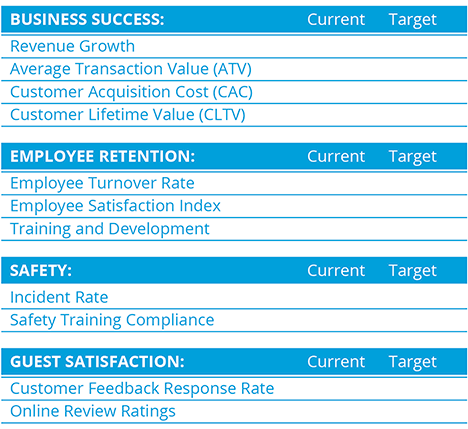As many readers can attest, adventure parks have gained immense popularity, offering all kinds of unique experiences to visitors seeking outdoor adventure. However, successful operations require careful management and monitoring of a variety of key performance indicators (KPIs)—quantifiable measures that show how successful an organization is in meeting performance objectives.
KPIs provide valuable insights into efficient park operations, and by effectively measuring and analyzing them, adventure park stakeholders and managers are better equipped to ensure business success, employee and guest satisfaction, and safety. That said, what are the “essential KPIs” for aerial adventure attractions?
1. BUSINESS SUCCESS
Essential number one, business success, goes beyond revenue and expenses, taking into consideration customer loyalty, retail add-ons, and the cost of attracting new business.

A chart like this helps track key performance indicators.
Revenue Growth. Revenue growth serves as a vital KPI for any adventure park. While revenue can be a lead indicator, by focusing on earnings (revenue less expenses), managers can track the overall financial health of the park. Monitoring earnings growth helps identify trends and assess the impact of marketing efforts, and can inform decisions regarding pricing, promotions, and investment in new attractions. By comparing revenue and earnings growth over time, park operators can evaluate the effectiveness of their business strategies.
To achieve consistent revenue and earnings growth, park operators should adopt a multi-faceted approach: identify and capitalize on expansion opportunities, and diversify revenue streams through expanding sales channels, adding premium services (i.e., private access or party areas; food options; merchandise packaging), and implementing pricing strategies that consider peak and off-peak times. Additionally, optimizing your schedule of operating hours may be the simplest tool to optimize staff costs while maximizing throughput. It doesn’t make sense to open at 7 a.m. if your general admission guests don’t typically arrive until 10—unless you can find a way to fill those empty hours with paying guests.
Average Transaction Value (ATV). The average transaction value is the total spending per guest. This figure goes beyond the base ticket price to include such items as upgrades, retail products, and food and beverage. Increasing the ATV is crucial to boost revenue. To achieve this, offer enticing add-ons and packages, enhance the overall guest experience, and ensure effective merchandising and pricing strategies.
More specifically, adventure parks can introduce premium experiences or upgrade options that provide added value to visitors. If operators carefully curate merchandise and offer high-quality products that align with their parks’ themes, they can encourage guests to make additional purchases. Moreover, strategic placement of F&B outlets as well as offering diverse dining options can further increase ATV. Keep in mind that ATV will be affected negatively by offering discounts, but this can be countered by increasing volume.
Customer Acquisition Cost (CAC). In a watch store recently, I witnessed a man get turned away because the staff “did not have time” to install a new band. They offered for him to come back the next day, but he was unhappy and seemed unlikely to return. I questioned how much the store must have spent to attract the customer, only to lose him completely.
Customer acquisition cost refers to the expenses incurred to attract new customers. Understanding different customer types and their associated CAC can help optimize marketing efforts and allocate resources effectively. By identifying the most cost-efficient customer acquisition channels, i.e., digital advertising or partnerships with local tourism agencies, parks can streamline marketing strategies and maximize ROI.
To reduce CAC, leverage digital marketing techniques such as search engine optimization, targeted online advertising and email, and social media campaigns. Analyze customer data and behavior so you can tailor messages to specific customer segments and enhance the effectiveness of your acquisition efforts. Additionally, nurture partnerships with local businesses, tour operators, and hotels. This can lead to mutually beneficial promotions and referrals, lowering acquisition costs.
Customer Lifetime Value (CLTV). The customer lifetime value represents the total revenue generated by a customer over their entire relationship with the adventure park. It considers repeat visits, additional purchases, and referrals. To increase CLTV, cultivate customer loyalty through exceptional experiences, personalized marketing initiatives, and targeted loyalty programs. By enhancing customer satisfaction and engagement, adventure parks can extend the CLTV and drive long-term profitability.
How can you deliver exceptional guest experiences?
• Provide excellent customer service, personalized interactions, and memorable moments throughout the visitor journey.
• Implement a robust customer management/reservation system to help track and analyze guest interactions, enabling targeted marketing campaigns and personalized offers.
• Create a loyalty program with exclusive benefits and rewards to encourage repeat visits and customer advocacy.
2. EMPLOYEE RETENTION
Staff satisfaction, training, and development can affect the essential employee retention/turnover rate. In general, the higher the turnover rate, the more it costs to train and develop new employees.
Employee Turnover Rate. High employee turnover can significantly reduce the efficiency and consistency of adventure park operations. Measure the employee turnover rate to discover valuable insights into the park’s work environment and employee satisfaction levels. It is crucial to monitor turnover rates for both front-line staff and management positions. To reduce turnover, it is usually necessary to address factors such as compensation, training, and career development, as well as create a positive and supportive workplace culture.
Adventure parks should prioritize attracting and retaining talented individuals who are passionate about delivering exceptional guest experiences. To that end, offer competitive compensation packages, provide opportunities for career advancement, and foster a positive work environment. Regular feedback sessions, open communication channels, and recognition programs can also contribute to increased employee satisfaction and loyalty.
Employee Satisfaction Index. It’s essential to assess employee satisfaction so operators can understand the needs and concerns of the workforce. An employee satisfaction index can be measured through surveys, such as an internal 360 review, that cover various aspects including work-life balance, training opportunities, job satisfaction, and overall organizational support. By actively listening to feedback and addressing problematic issues, adventure park operators can boost employee morale, increase productivity, and foster a loyal and motivated workforce.
Training and Development. Investing in the training and development of employees is crucial for maintaining high operational standards and guest satisfaction. This also boosts employees’ confidence and job satisfaction.
After investing, it’s essential to track the effectiveness of training programs, assess employee performance, and provide ongoing development opportunities. Make training and development a top priority, and ensure that employees are equipped with the necessary skills and knowledge to deliver exceptional experiences and handle safety procedures efficiently.
To this end, establish a comprehensive training program that covers several aspects of operations, including guest service, safety protocols, emergency procedures, and technical skills. Regular training sessions should provide opportunities for career advancement and cross-training and enable employees to grow within the organization, improving retention rates. While internal training is valuable, send employees to industry training programs and pay for certifications; these are two of the best investments an adventure park operator can make.
3. SAFETY
Park safety is always a top priority. While the adventure park environment inherently holds some risk, no one wants to create or tolerate unnecessary risks. To that end, incident rates for both employees and guests are important KPIs, as they indicate how well your park is controlling risks.
Incident Rate. Measuring the incident rate for both employees (beyond statutory compliance) and guests provides insight into the effectiveness of safety protocols and training. A robust incident reporting and investigation system allows for the timely identification of potential safety hazards and the swift implementation of preventive measures.
It is crucial to analyze incidents by severity, and to differentiate between those caused by visitor and employee behavior and those resulting from activity design flaws or equipment failures. Conduct comprehensive risk assessments to help identify trends and implement corrective actions. The aim is to continuously improve safety measures and minimize the occurrence of accidents.
Safety Training Compliance. To maintain high safety standards, regularly review and update safety procedures, conduct comprehensive training sessions, and foster a safety-conscious culture. Safety training frequency provides a measurable indicator of the park’s commitment to safety.
Establish a safety training program for all employees and provide refresher courses periodically. Train staff members to effectively manage guest behavior and provide clear instructions and safety guidelines. Recognize and reward employees who prioritize safety, as this helps create a culture where safety is ingrained in daily operations. Managers should actively engage with employees and encourage them to report any safety concerns and participate in safety initiatives. These actions contribute to a safer and more enjoyable experience for visitors.
Run regular safety drills to ensure compliance with safety protocols. Drills and simulations help employees develop muscle memory for emergency situations and ensure they are well-prepared to handle any unexpected risks.
A final point regarding safety: an investment in high-quality equipment can help keep incident rates to a minimum.
4. GUEST SATISFACTION
To measure guest satisfaction, talk to customers, ask their opinions, put yourself in the mix, and solicit reviews.
Customer Feedback Response Rate. Guest feedback is crucial in order to identify areas for improvement. Implement multiple channels to capture customer opinions, i.e., suggestion boxes, online surveys, and real-time feedback systems.
The customer feedback response rate provides insights into the park’s attentiveness to guest concerns and suggestions—and into the intensity of their satisfaction with the experience. Analyze guest feedback trends to identify recurring issues and enact improvements that enhance the overall experience.
It’s wise for park managers to mingle and interact with guests, and promptly address any issues they raise. Immediate and appropriate action demonstrates a commitment to guest satisfaction and encourages guests to volunteer their perspectives. Targeted surveys can provide deeper insights.
Online Review Ratings. Online review platforms have become influential sources for potential guests. Monitor review ratings and comments to help gauge guest satisfaction levels, identify areas of excellence, and address negative feedback. Consistently strive for positive online reviews and ratings; these help build a strong reputation and attract new visitors.
To manage online reviews effectively, monitor review platforms regularly. Respond to both positive and negative reviews in a professional and timely manner, and address any concerns. Take the time to acknowledge positive feedback, and proactively resolve issues mentioned in negative reviews—that demonstrates a commitment to guest satisfaction and cultivates a positive online presence. Encourage satisfied guests to share their experiences online, as this can help generate positive reviews and enhance the park’s reputation.
EMBRACING KPIS
Efficient management of adventure attractions requires a comprehensive understanding of key performance indicators across many aspects of park operations. A focus on business success, employee retention, safety, and guest satisfaction allows stakeholders and managers to make data-driven decisions that optimize operations and ensure memorable guest experiences. Embrace these KPIs and they will contribute to long-term success and profitability.






